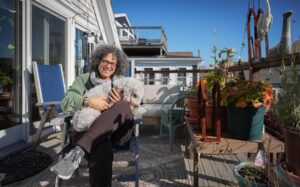Cherie Mittenthal arrived at the sedate Truro Center for the Arts at Castle Hill 21 years ago. She’d left a job in Hartford heading up educational and arts programs for kids and families.

Her energy, creativity, and managerial know-how have turned a sleepy summer program into a vibrant year-round set of widely varied classes in the arts serving a broad population.
In the sunny second-floor apartment next to Castle Hill’s tower, with the happy uproar of an after-school program going on below us, Mittenthal sat down with me to talk about her life and work.
Sharon Basco: You’ve been trained in both music and painting since childhood. Did you ever feel that you had to choose one or the other?
Cherie Mittenthal: Music was my biggest claim to fame. When I was 16, or maybe 17, I got called in by the Bridgeport Symphony — they needed a second oboe player because their regular one was sick. I played with the orchestra and Dave Brubeck and his son. It was great.
But deep down I thought, “Well, it’ll probably be easier to make a living as an artist than as a musician.” So that was what I chose to concentrate on in graduate school at Hartford Art College. Little did I know, neither of them was a way to make a living.
SB: The late Joyce Johnson, a sculptor, founded Castle Hill in 1971 when she brought people together to save a gorgeous barn that had been used to house farm animals and was going to be torn down. Back then, it was just a little summer-only place with a few classes. What was it like by the time you got here?
CM: When I started in 2002, there was zero staff. Just one part-time person who hated the computer, so there was nothing computerized. Literally all the paperwork, all the registration was done on a pad of paper. There were the same 60 classes every year. The budget was $250,000.
SB: And now, what’s it like?
CM: I grew the organization through programming. The board has been supportive with fundraising over the years, plus we have received many cultural facility grants.
So, now our budget is a little over a million. We have eight people working here year-round. We offer around 220 classes every year. Seven hundred to 1,000 students join us from all over the world for a breadth of subjects: welding, sculpture, writing, storytelling. We have a dozen studios, gallery spaces, and perhaps the last darkroom on Cape Cod.
In 2016, we partnered with the Truro Conservation Trust to purchase Edgewood Farm. It took us three years to raise the money. There are five buildings, and we house nine artists there. It’s seven-and-a-half acres, plus we have a wood kiln. And we just put a welding pad in the back of the wood shop. We built this amazing outdoor stage that’s gorgeous.
SB: And you recently brought in another building from Ballston Beach, right?
CM: On a Tuesday afternoon in 2018, I get a phone call from the town saying, “We have this little shed from the 1800s that was the horse barn for the house that we’re taking down at Ballston Beach. Would Castle Hill like this little house?”
And I was, like, “Totally!” Three of us hurried over there to Ballston in the freezing cold, watching them strap up this building, put it on the back of a flatbed truck and drag it over to Edgewood.
SB: What role do you see Castle Hill serving for the larger Outer Cape community?
CM: It’s about building bridges. I was on an economic task force in Provincetown, and I found that the Provincetown Business Guild and Provincetown Chamber of Commerce never talked. They’re both organizations working with local businesses, but they hated each other. In this tiny little town! I came from Hartford, where I was a bridge builder, able to draw people together, and that didn’t make sense to me.
One of my big goals with Castle Hill was to bridge gaps, to expand our community, and to make it such that Provincetown and Truro and Wellfleet are talking to each other. It’s a tiny little world we live in out here.
And here we are, 20 years later. We have a good relationship with the Provincetown Art Association and Museum and the Fine Arts Work Center. For the first time, I feel like we’re having a good time with one another. We’re not competitive; we actually have a couple of grants that we’ve done together around a state earmark.
SB: What are your next goals for Castle Hill?
CM: When I started at Castle Hill, there was a bit of a reputation of it being very “New York” and elitist. We’re trying to be more creative in bringing a younger and more diverse crowd.
SB: While life at Castle Hill was flourishing, you’ve had a lot of personal challenges in recent years. Two women who you had close romantic relationships with — Carla Anderson and Dotty Mulcahy — died within just a few years of each other.CM: I don’t know how I got through it — probably by working a lot, focusing, and I had a lot of support from the community and friends. Carla passed away in 2016, and then Dotty passed away in 2019. Two great personalities, wonderful people. That was hard. And I think the hardest part was that everybody knew them. For a year, every single time I ran into somebody they would say “I’m so sorry — Dotty was so great.” She was, and I want to keep that memory alive. And then Covid hit.
But now I’m doing well. And I have a new love and that’s a wonderful thing.



